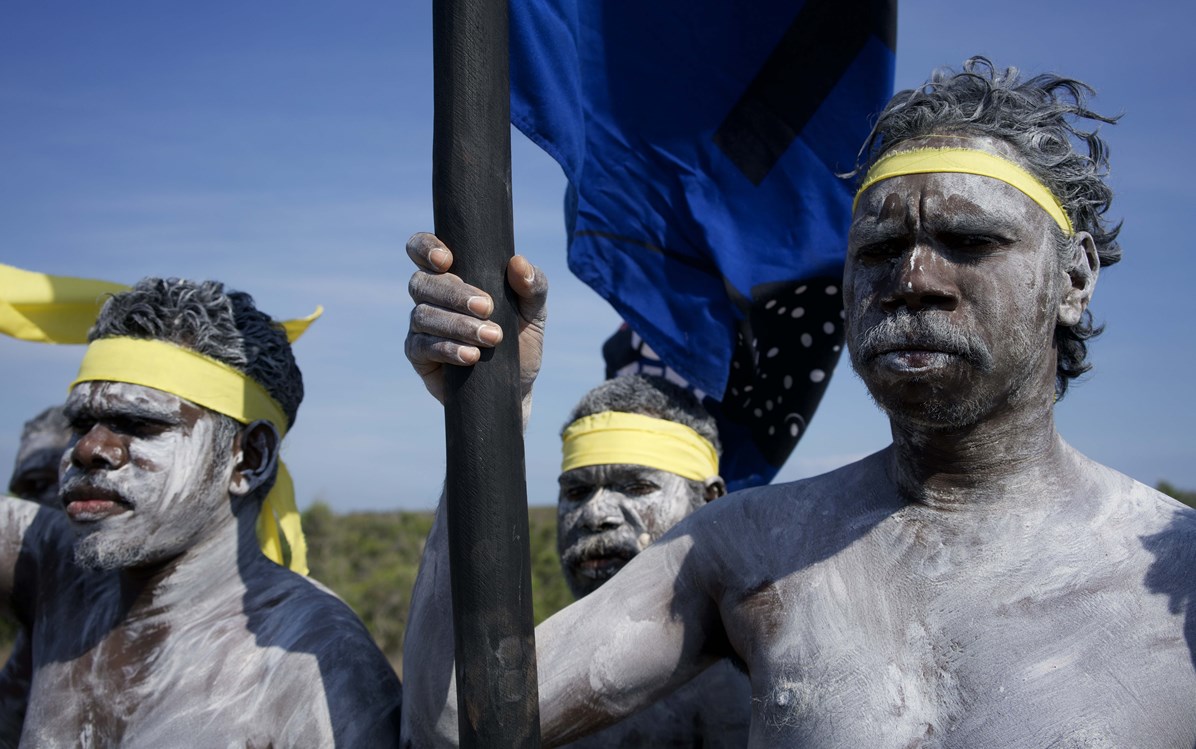Image description: three Indigenous Australian men – with a thick, yellow bands around each of their foreheads, and covered in white paint – look seriously into the distance. One holds a thick, black flag mast, which flies a multi-coloured flag.
By Riva-Jean Lander
A pale haze filled the room of the Perth Concert Hall in Dyeedyallalup (Perth). This was the first sign that the audience was entering a new world; a world which leaves you feeling insignificant, yet enlightened.
This is Buŋgul. It is a series of ceremonies which share deep ancestral knowledge about the land of the Yolŋu people of North East Arnhem Land, Australia. It extends beyond that Country, and becomes a message providing a greater understanding and appreciation for the environment.
Initiated by the Yunupiŋu family and music label Skinnyfish Music, and commissioned by Perth Festival, Buŋgul is a beautiful melding of song, dance, music, art and videography. Directed by Don Wininba Ganambarr and Nigel Jamieson, the performance revolves around the last album of Yolŋgu multi-instrumentalist and singer, Geoffery Gurrumul Yunupi. At the time of his passing in July 2017, Gurrumul was the best-known Indigenous musician in Australia’s history.
In Buŋgul, each song of the album Djarimirri (Child of the Rainbow) is danced by Gurrumul’s family in a large circle filled with sand. This was accompanied by the seamless transitions and remarkable harmony created by Yolŋu song-men and musicians, and the West Australian Symphony Orchestra (WASO). Gurrumul’s powerfully emotive and resounding voice echoed over the music.
Connections between all the natural elements of the land are elegantly reinforced in every expression of the word that is focused on in each section. One section was about Djiḻawurr (scrub fowl). It is represented in the dancer’s movements and actions, as he scratches the land with his feet to form a nest. Djiḻawurr is also sung, shown in a painting by Gumatj artist and ceremonial leader Yumutjin Wunu, and a sweeping video over the scrub-land where the Djilawurr is projected onto the screen behind the Orchestra.
At times, the dancers looked out into the audience. The intensity of their strong eyes and an unwavering gaze is exquisitely mirrored in the WASO performance, and Gurrumul singing his ancestor’s songs.
There were also well-placed comedic moments. During the song Djoli dancers moved around the circle holding a painted wooden instrument. At one point, one of the dancers seemed to improvise, and played the instrument like he was performing a Jimi Hendix guitar solo. He playfully smiled, and cupped one ear to hear the audience clap.
While this may feel like a long performance, every part is entirely necessary, and it is a true privilege to be invited to learn about this land. And more than simple watching, you are being taught. Before each song began, the word of its title (and the moiety, clan and language group from which it is translated) are shown on the screen. Learning these words, this knowledge, and this deeper appreciation for the land left me with a humbled view of our country.
Rising and falling from intensity to gentleness, images, rituals and knowledge combine on the screen and in the Concert Hall, as we journey through this performance. Buŋgul is a must-see for anyone who lives on or visits Australia.
Buŋgul ran at the Perth Concert Hall between the 7th and 9th of February.
Riva is an architecture student, with a Bachelor’s Degree in Anthropology and Sociology.
Image courtesy of Perth Festival.

